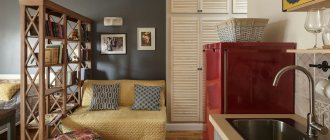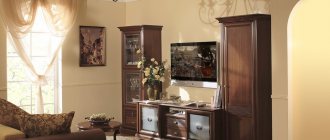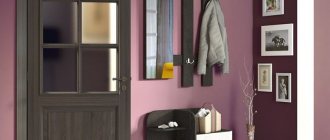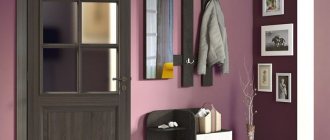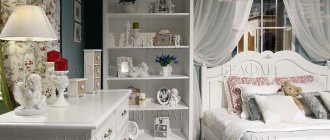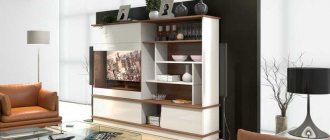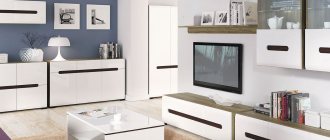Room layout
Living room layout
Measure your living room from wall to wall, taking into account the length and width of the room.
First draw a diagram, noting measurements on all sides. Whether you create it in a computer program or draw it by hand on graph paper, a scale floor plan will be extremely useful for planning any kind of space.
The easiest way to convert meters is on a scale of 1:2, where 1 m2 is equal to 2 notebook cells.
For example, a living room measuring 13 by 25 m2 will turn into a diagram measuring 26 by 50 notebook cells. Next, measure any furniture you decide to include and create a separate diagram with a unique size for each piece.
If you're drawing by hand, I have an idea that involves creating mock-ups of paper furniture (to scale) by cutting it out of the paper so that it's easy to play with different furniture variations.
Determine the focal point
Deciding on a focal point will really help in planning the space - TV, fireplace, chandelier, artwork, etc. Once that is decided, the furniture pieces will fit around it.
If there is a TV in the living room, please note that the viewing distance of a standard TV is between 2.5 and 3.5 m and the viewing angle is no more than 30 degrees. Thus, the main sofa, daybed or sectional should be positioned against this wall.
Additional armchairs and chaises can also be placed against either side of the TV wall, rounding out the seating area while adding visual balance.
For living rooms with a fireplace, the most important purpose, according to most people, is conversation. Thus, a semi-circular design of furniture around the hearth, with no more than 2.5 m between seats, promotes easy interaction with family and friends.
For living rooms where there is neither a fireplace nor a TV, a central focal point makes the most sense.
Place a sofa (or two, facing each other) around a coffee table, with chairs arranged in a circle to cover any gaps.
Arrange the table, wardrobe and sofa
Once the seating area is set (around the focal point), place the table and cabinet next to them.
In the living room, the main coffee table or ottoman can be placed between the sofa and chairs. It's best to leave 50cm between the coffee table and the sofa so that drinks and the TV remote are within reach. The cabinet can be placed behind the sofa.
Be sure to leave at least 30cm between pieces of furniture in areas where people need to pass. For small spaces, consider folding tables that can fold out when in use and fold away when not in use.
Storage cabinets and chests of drawers are placed against the wall where space allows.
Media consoles and TV stands go under the TV, and a buffet is usually placed along the longest wall. Tall shelves and open cabinets that hold mementos, books, accessories and family photos look better on a larger, empty wall so it doesn't look crowded.
Bar cabinets and carts are elements that add an aura of glamor to the living room.
Consider floor and table lamps
Floor lamps take up part of the table, so a coffee table should be within reach for guests to place drinks.
There are some floor lamp designs that come with an accompanying table.
Table lamps are self-explanatory—just make sure they don't take up the entire tabletop. Chandeliers should be concentrated above the main seating area. Recessed lights make sense anywhere on the ceiling since they don't droop.
Spot lighting can draw attention to artwork, sculptures or a library.
Center your mat
The last element of living room furniture design is also the simplest: the rug. It should be centered in the middle of the main seating and extend a few inches under the sofa and armchairs (or even further) to anchor the entire room.
If the room is already carpeted, adding a thicker accent rug on top is a great way to add warmth and encourage guests to relax and stay a while.
By following these simple steps to designing your living room furniture, you'll ensure that your space is a pleasant place to relax and flow into the rest of your home. Here are more questions to ask yourself:
What do I want to see first when I walk into a room?
what do I want to see on the walls - will there be an air conditioner or a radiator?
will there be zones or dividers designed in the room?
Basically, figure out what's most important to you before you start decorating or buying furniture, and you'll be able to create a special space that reflects your personal taste.
How to arrange furniture in the bedroom
In the bedroom, the furniture set is usually arranged symmetrically, since this room is intended for relaxation and there is no place for extravagance.
A central place is usually allocated for the bed, with the headboard facing the wall, and a bedside table with a lamp is placed on each side. In front of the bed you can place a chest of drawers with a TV or mirror.
A closet against one of the walls completes the ensemble.
It is more difficult to achieve a symmetrical arrangement if the bedroom is combined with a study: the place to work will introduce dissonance into the energy of the room. You will have to balance the decor with similar pieces of furniture, placing them on opposite sides.
This way you can create harmony in the interior.
As an option, buy a desk made of similar material; It will also be possible to balance the situation by placing a chest of drawers or a cabinet. A beautiful screen can become a partition, and you can also work with the lighting or highlight the area with a different wall color.
In a small bedroom, you can place the bed along the wall, so it will not interfere with the passage. Keep in mind that according to Feng Shui, the bed should not be placed opposite the door. Installing a beautiful wardrobe can serve as a starting point for arranging furniture.
Having decided on the position of the wardrobe, you can arrange the rest of the furniture.
For a dressing table, you can find a place at the foot of the bed or place it in a corner by the window. It would be nice if there was room left for a brightly colored ottoman or a small armchair with cushions.
Arranging furniture in the kitchen
For rational placement of furniture in the kitchen, the triangle principle is suitable:
- The stove and sink are located a short distance from the wall.
- There is space for a refrigerator on the opposite wall.
You should get something like an isosceles triangle. With this arrangement, the housewife can easily and freely move in her kitchen while cooking.
If possible, the dining area should be placed somewhat further away from the kitchen, because nothing should interfere with the creative process of preparing culinary masterpieces.
If the kitchen is long and narrow, a parallel arrangement of work lines will do. The most convenient width between surfaces is about 110 cm. In a small kitchen, they use the U-shaped method of placing objects and the triangle rule for installing a sink, stove and refrigerator.
Kitchenettes use an L-shaped arrangement.
Arranging a nursery
Contrary to the conventional wisdom that a nursery should be cute first and foremost, I want to argue and say that this room should be functional and safe first and foremost.
Think about what could be dangerous for your child and eliminate these things first.
The stop list includes such things as:
- natural mirrors (replace them with special plastic ones intended for children);
- all kinds of sockets (insert blockers that you can buy at IKEA);
- handles from plastic windows that need to be pulled out, first adjusting the safe ventilation mode;
- insufficient lighting (place night lamps and other light sources).
Functionality
The functionality of a children's room is especially important for a baby in the first years of life - in this case, you should carefully consider night feeding and the trajectory of the mother's movement through all the obstacles that may be encountered along the way.
A sufficient amount of light, a feeding area with a comfortable rocking chair next to the crib will make life calm not only for the mother, but also for the baby.
Many experts recommend that you keep your baby's crib away from windows, as temperatures tend to be cooler near windows and there's also the risk of your baby tearing off blinds or curtains. Placing a baby crib near the interior wall of the house will be a warmer, calmer place and inaccessible from outside noise.
Also make sure that any lamps or accessories are kept at a safe distance so that the child cannot remove them or they will not fall while he is sleeping.
Of course, above all else, you want the children's room to look perfect and have the "wow" factor. The crib is the key focal point in a nursery and is the first thing people pay attention to.
I recommend, if other factors allow, to place the crib somewhere where it can be seen in the doorway.
There are several different options for crib placement, depending on the size of the room and the look you want. First of all, you can place it in the middle of the wall with the headboard against the wall. This is perhaps the most common location and allows for other pieces of furniture to be placed on both sides.
In larger rooms, the crib can be placed in the middle of the room.
Much of the atmosphere that makes a nursery special comes from the accessories. A tasteful piece of art, a few pillows and a cute rug will be the icing on the cake in any child's decor, as long as the structure is in place.
Add a couple of paper lanterns and a small potted flower.
How to place furniture in the living room
How to place furniture in the living room photo
Proper arrangement of furniture in the living room is the key to the cozy atmosphere of the entire apartment as a whole, because residents spend quite a lot of time in this room: watching TV, greeting guests, gathering to discuss over a cup of tea.
The arrangement of furniture in the living room is influenced by: the size of the room, the shape of the room, its purpose or style. Based on these criteria, it is necessary to choose the quantity and shape of those pieces of furniture that you will need.
The issue of zoning the living room is a very important point, which allows you to divide the room into conditional zones-islands for various purposes. There are several rules that will help turn even an ordinary room of a “simple” shape into a cozy and harmonious room for the whole family.
- The TV, an integral attribute of the living room, should be installed in the center.
- A seating area (sofa and, if necessary, armchairs) is located opposite the TV.
- If necessary, furniture for the dining room (dining table) is installed directly next to the light source, preferably a window.
- It is better to abandon bulky cabinets and replace them with stylish bookshelves.
A sign of the correct layout of the living room is the presence of free space after installing all the necessary items, which is so necessary in the guest room.
Arrangement of furniture depending on the area of the room
Furniture for a room is chosen depending on its dimensions - massive objects will fit organically into a spacious room, but will look bulky in a room of medium or small size.
Depending on the area of the room, the number of furnishings is chosen. The more spacious the room, the more additional elements you can add.
The smaller the room, the more functionality the furniture should have.
In a large room, it is possible to organize several functional areas; in this case, furniture is used to divide the space - sofas, through shelving, and bar counters are used for these purposes. Insufficient furniture in a large room will make it empty and uncomfortable.
Important! Sources of natural light should not be cluttered with furnishings.
A studio apartment should be considered a large room. Where there are several functional zones in one space and the main way of zoning is the competent arrangement of furniture, accent details, selection and design of artificial and natural lighting.
In a spacious studio apartment, it is possible to organize an independent sleeping area and a living room area, separating them with a mobile partition or a through shelving unit.
If the room area is small, then these two zones are combined using multifunctional furniture. The transforming sofa turns into a full-fledged sleeping place at night. Also, the living room area can be freed up by using built-in furniture, when the bed is hidden for the day in a podium or in one of the sections of the closet.
You can make a podium bed yourself. This design has functionality due to the presence of roll-out drawers.
Furniture for a studio apartment often has dual functionality. For example, the bed is equipped with drawers for linen. Mobile and folding furniture are popular.
Note! Open shelves in corners and on walls, as well as mezzanines above doorways, allow you to save free space.
A good layout option is a studio apartment with a bay window, the space of which is used to organize a dining area, a place to relax or a workplace.
When arranging furniture in a small room, consider the following:
- It is advisable to replace the usual cabinet furniture with a small wall slide and a functional sofa-book near the wall - this will free up space in the center of the room.
- To functionally divide a small room into zones, through shelving of a simple design is used.
- Furnishings must perform several tasks. For example, a transforming sofa converts into a full-fledged sleeping place and is equipped with spacious drawers for linen.
The coffee table is equipped with drawers and shelves for storing books and magazines.
- To make a small room feel more spacious, preference should be given to furniture with laconic facades and fittings, without pronounced decor.
- When decorating a nursery designed to accommodate several children, you can save free space through the use of multifunctional furniture, loft beds and bunk structures.
How to arrange furniture in a small room
It's not as difficult as it seems:
- First, respect asymmetry.
- Secondly, place large items closer to the walls.
- Thirdly, try to give as much light as possible to the room, this will visually make it more spacious.
- Fourth, you can use furniture designed specifically for small spaces: bunk beds instead of two beds, built-in dishwashers, washing machines, stoves, pull-out cabinets and much more. Things like this make the task quite easy.
General rules and recommendations for furniture placement
Each room in the house is endowed with special functionality, has individual sizes, shapes, and a specific arrangement of door and window elements.
There are several general rules that will help correct shortcomings and highlight the advantages of any room.
First of all, you need to determine the parameters of the room and each piece of furniture. Using your measurements, draw a plan on graph paper. Separately, prepare cut-out paper images of furniture to scale. Models can be drawn or made three-dimensional, giving the layout even more realism.
Select the main element of the room. The center of the living room can be a sofa, TV or fireplace. The bed will dominate the bedroom. There is a dining table in the kitchen. Choose a location for the main element of the room and proceed to arranging the rest of the interior items.
Arrange the remaining furniture so that the gaps between each element range from 1.8 to 2.4 m. Free space is necessary for comfortable movement between objects.
Think about filling the corners. In small rooms it makes sense to use them to the maximum. Fill them with corner cabinets or create a separate reading area with an armchair and coffee table. You can decorate a corner by placing a decorative floor vase or floor lamp in it.
When arranging a sofa, armchairs, tables and chairs, make sure that the distance between them does not exceed 0.8 m. These objects should be at arm's length.
To make the most of a small space, place your paintings as high as possible. Install full-wall mirrors. They will make the room twice as large and fill the room with light.
In the big room
The living room is the largest room in the house. This is where the fantasy should unfold. Unfortunately, we often see how a spacious room is turned into an uncomfortable space with furniture placed along the walls. Meanwhile, proper zoning can turn such a room into a stylish, and most importantly, comfortable interior. The placement of the filling must be carefully considered. Each item should fit organically into the interior, be located logically - be in its place.
Before you start arranging furniture, you need to understand what zones you want to highlight in this room. Separate parts of the living room can act as:
- seating areas with sofa and TV;
- dining room - with a large dining table and chairs;
- an office where a desk and separate lighting are required;
- bedrooms, with a full bed, bedside tables and wardrobe.
Having decided on the necessary zones, you can begin arranging the furniture. Thanks to the layout, the risk of making a mistake during purchase will be reduced to zero. You know in advance the dimensions of the necessary furniture, so you don’t have to “reinvent the wheel” later. Furniture with the necessary parameters will ideally fit into the space allocated for it.
Large rooms most often have a simple geometric shape. But there are non-standard living rooms - with five corners or semicircular walls. A must-have for correcting such premises is built-in furniture, made to order.
In the central part of the room, install large objects - a sofa group, a chest of drawers. It is not advisable to place the sofa or chairs with their backs to the door.
The western wall is the best place to install a TV and other video equipment.
In a small room
Arranging furniture in a small room is a headache for apartment owners. How to cram in everything you need to get a beautiful and comfortable interior.
We recommend using the following tips:
- give up bulky cabinets in favor of a compact shelving unit or small cabinet;
- replace the bed with a folding sofa like a book or accordion. This will ensure maximum free space during the daytime;
- If necessary, zone the room using transparent partitions or shelving with open shelves. They do not clutter up the space as much as compared to blank walls or cabinets;
- to save space for games in a children's room intended for two, it is better to install a bunk bed;
- use multifunctional furniture - a sofa with storage space, a coffee table with shelves, a bed that can be transformed into a desk or wardrobe;
- use the window sill space - it can be turned into a desk, a place to relax, read or play;
- Make use of the area around the window by building in floor-to-ceiling shelving with storage drawers and a pet house;
- furniture should be as simple as possible, without an abundance of decor or carvings;
- choose products with rounded corners - in a confined space there is always a high risk of injury.
In a small room you need to place interior items along the walls and in the corners. This will give you more freedom. The main condition is that before going to the store, take the time to develop a plan, or even better, make a model of the future room.
In a studio
Correct zoning and a well-designed lighting scenario are the main requirements for studio design. The designer’s task is to place in a limited area everything necessary for the comfort of the residents. And here again it’s worth calling on built-in furniture to help. This will greatly increase the cost of the project, but will make it possible to accommodate everything you want without depriving residents of free space.
In the studio, the need for zoning becomes a prerequisite. The open kitchen area needs to be at least visually separated from the living room. This can be done using a sofa set with its back facing the kitchen. Often a chest of drawers or a shelf with a height approximately the same as the back of the sofa is used to help him. Vases, flowers and other functional or decorative elements can be placed on the surface. They will make the border between zones even more obvious.
A bed in a studio apartment should have compartments for storing bed linen, blankets and pillows. Here, as in a separate small room, transformable tables and chairs are relevant. It is better to choose light furniture, preferably with glossy or mirrored facades, which will visually make the room twice as large. The head of the bed or bookcase can act as a partition. For storage of things it is worth providing hanging mezzanines. The entrance area should be equipped with a banquette, with shelves for storing shoes. If the studio has a bay window, this is an excellent opportunity to place an additional area in it - a workplace, a nursery, a library, a winter garden. It is better to choose built-in furniture, which will repeat the semicircular shape of the architectural element and will not allow a single cm to “gap”.
In a narrow or elongated room
An overly long room can be visually shortened with the help of a cabinet, shelving unit or fireplace group installed against a short wall. If the room is extended due to a bay window, place a dining area in it and admire the city views while eating.
Light, simple-shaped furniture will add volume to a narrow room. It will visually expand the space. It is better to decorate the window with thick curtains, which will stand out and bring the short wall closer, making the room more square. Minimize the number of shelves on long walls, or at least do not clutter them with an abundance of decorative elements.
What is an online planner
The essence of online interior planners is that these programs allow you to draw a three-dimensional plan of an apartment, kitchen layout, virtually arrange furniture and see how it will look. They differ in the level of capabilities, but the basis is the same: the user selects a room layout, sets parameters - and can see a three-dimensional model.
Well, then you can add furniture.
Our opinion: - It’s also good that there are a lot of free planners (in some cases you need to register on the owner’s website, in some - not).
Simple Schedulers
The simplest planners create a flat drawing of a room, familiar to most of us from school drawing lessons.
This is the simplest option - an analogue of a drawing with a pen on paper; it is usually needed if the room has architectural elements of complex shape - fancy protrusions, niches, and so on, which are sometimes difficult to visualize on your fingers.
Volume planners
The second option is more interesting, it allows you to create a three-dimensional color model. You can set the dimensions of the furniture and rotate them: try several options for kitchen sets, rearrange items around the room in search of the best place for the bed.
You can change the color of the walls and floors, move partitions, move windows and doors (this is often required by those who are building their own house) or look for the most convenient place for the distribution panel.
Complex schedulers
But the most interesting option is “advanced” planners, which allow you to create a complete three-dimensional model of the room.
In them you can set not only the color and size, but almost everything: the shape of pieces of furniture, style, any decorative elements, etc. What the room will look like if you move the partition and put a sofa in the partition, red furniture in the kitchen, a green carpet, or, conversely, whether this wall should be painted a different color and, if so, what color - you can see all this.
Our opinion: - The resulting model can be seen from all sides, rotated and even watched like a movie if the program has a “virtual tour” function.
Planners from furniture manufacturers
A special place is occupied by planners from large manufacturers (furniture, windows, doors, partitions, and so on). On their websites you can set the parameters of your room, and then “arrange” your favorite furniture from the manufacturer’s catalog in it and see how it will look specifically in your case.
The most famous of these planners is from IKEA.
Complex layout
Planners can help in cases where the room has a complex, non-standard shape. It will also help when planning artificial “difficulties” - when creating a niche, a bay window or a complex suspended ceiling.
They come in handy in cases where you can’t choose a piece of furniture—a kitchen set, for example. The ability to look in such cases is an irreplaceable option.
Where to begin?
First you need to decide where the focal point will be located - this is the main part of the room with the elements to which the viewer’s attention is immediately drawn. This center usually coincides with the functional one.
For example, in the living room its role can be played by a plasma or fireplace. If there is no fireplace and there is no TV in the living room, you can create a soft seating area around a small tea table.
The presence of a focal point in each room of the apartment is required in order for the entire composition to look logical. We don't realize it when looking at the interior, but the brain immediately looks for the center. And if it is not there, the situation is perceived as disharmonious and uncomfortable.
In the bedroom this is usually a bed, in the nursery - a crib or play area, in the kitchen - a table. It all depends on the individual needs and habits of the owners.
Lighting and decor
Grouping furniture, in principle, will help avoid clutter. Agree, a comfortable soft corner for two, or maybe a whole company, is much nicer than a set of fashionable but impractical items.
The decor will help in arranging the necessary vertical accents.
Lighting is necessary both general and accentuating. We use floor lamps, wall and table lamps.
Plants, especially tall ones, are good not only for large rooms. They will brighten up the voids and significantly improve the overall appearance of the room.
Zoning rules
Zoning is an interesting, sometimes forced way to arrange furniture in a room. It is used where one room performs several functions at once. You can distribute the space into zones even at the renovation stage, for example, by gluing different wallpapers or laying different floor coverings (tiles and laminate) .
How can you arrange furniture in a room of 18 meters, photos of the best options
If the idea of zoning arose after the renovation, then less drastic methods can be used. For visual division use:
- small carpets dividing the space into parts;
- racks or other mobile partitions;
- cabinets or tables placed facing the wall, separating the work area.
It is very convenient to divide a room where there are two windows into zones, especially if they are located on different walls. So, under one opening you can organize a work area consisting of a computer desk and an armchair, and under the other you can place a sofa and armchairs, forming a relaxation area. If you use furniture stands, the zones can then be swapped.
A narrow room can be easily divided into parts if you place furniture in opposite corners, for example:
- install a bed for parents on the side away from the door, and place a children’s corner closer;
- organize a dining area near the kitchen window, and arrange a working L-shaped wall in the corner closest to the door;
- distribute the furniture in a narrow room into several zones - for watching TV, receiving guests, a computer corner.
Depending on the size of the room, the zones can be distant from each other, located nearby, or even partially overlap.
Selecting an area using a carpet
Shelving as a divider
Wardrobe partition
Children's and adult areas
Kitchen division
Work area separation
Options for arranging furniture in a one-room apartment
When deciding how to arrange furniture in a room in a one-room apartment, first of all, figure out which interior items are comfortable and useful, and which ones will only clutter the apartment. Avoid furniture that does not suit the needs of the people living in the apartment, their activities, age, habits and tastes.
In general, speaking about furniture, it can be divided into several groups:
- for sitting (armchairs, chairs, stools, banquettes, ottomans, soft corners), for sleeping and relaxing (sofas, beds, couches, sofa beds),
- for storing household items (cabinets, racks, walls, chests of drawers, whatnots, bookshelves, bedside tables),
- tables for various purposes (dining, kitchen, desk, coffee tables),
- as well as stands for video and audio equipment, telephone, flowers, mirrors, etc.
Depending on the purpose, furniture is usually divided into six main groups: for the living room (living room), bedroom, children's room, kitchen, hallway and balconies (loggias).
When purchasing furniture for an apartment, you need to choose the essentials. In addition, interior items should be easy to use for all family members and selected in the same style.
We should not forget about the color of furniture polishing: dark brown and light polishing cannot be combined in the same room.
When thinking about arranging furniture in a one-room apartment, consider the option of a furniture wall.
Properly selected to fit the size of the room, it performs two functions at once. It is, on the one hand, a very convenient storage of household items - from clothes, linen and dishes to various household items, and on the other hand, it is an interior decoration, since it is compact and looks very impressive.
Of course, a completely fair argument may arise: purchasing a wall cannot always easily fit into the family budget of a young family.
Don't be upset about financial difficulties. After all, if funds do not allow, you can build a rather successful semblance of a furniture wall from small individual cabinets and shelves, which are available in abundance in any apartment.
As you can see in the photo, when arranging furniture in a one-room apartment, individual objects, combined into a single whole with taste and imagination, can successfully replace a finished sectional wall:
Built-in wardrobes from floor to ceiling are also good - they also save a lot of space in the room. But in their production you will have to give the main role to your own spouse, although you may well participate in the development of the project as a consultant.
Wide three-door wardrobes usually do not look very good in a one-room apartment, where the room can simultaneously be a living room, a bedroom, an office, and even a nursery.
They take up too much space, they are difficult to move when it is necessary to rearrange the furniture (and such changes are quite often required in a one-room apartment, for example, in connection with the birth of a child or creating comfortable working conditions).
A good option for arranging furniture in a one-room apartment would be to install a shelving unit that either occupies space along the wall or is placed across the room, dividing it into two parts. In the latter case, the room is also divided into two zones; one is a place to rest and sleep, the other is a work area.
Or, if there is a child in the family, one part of the room is intended for parents, the other represents a children's corner.
Here is an approximate plan for arranging furniture in a one-room apartment:
Shelves do not look bulky, they save space in the apartment and can be used to store various things: books, dishes, toys, and so on. A good decoration for the shelves themselves are indoor plants with long climbing branches or artificial vines.
Shelves and built-in cabinets are very convenient for storing books, magazines, shoes, various household items, a vacuum cleaner, iron, children's toys, etc.
Basic placement methods
There are proven ways to place furniture in a room. Use them if you don’t want to rack your brains and subsequently move sofas and cabinets repeatedly, eliminating errors of incorrect placement.
Symmetric
This method involves placing furniture in pairs relative to the central element. Such a place does not have to be the center of the room. Objects can be placed in pairs relative to the TV, window, painting, corner or fireplace. With this arrangement, furniture of small or medium dimensions is used. This method is ideal for a square room. It may look like this: in the center there is a fireplace, and on either side of it there are two armchairs, a coffee table with identical sofas on both sides, a bed with bedside tables on the sides. Furniture must be made in the same style. You can continue the symmetry with the help of lighting and decor - identical lamps near the bed, photographs in the same frames near the TV, two candlesticks on the edges of the fireplace or chest of drawers.
Asymmetric
The asymmetrical method is more often used in walk-through rooms or rooms of non-standard shape. In certain locations - the kitchen, children's room - such a furniture arrangement is dictated by the need for functional zoning of space. Despite the asymmetry, objects in the room should not disturb the visual balance. Harmony can be achieved by balancing pieces of furniture according to the following principle - grouping small objects or placing small elements in the center of the window area, or against the background of a contrasting wall. In order to make bulky furniture visually lighter, you should place it against a neutral wall, closer to the center of the room or diagonally.
Circular
The method implies the presence of a central element. This could be a table or a chandelier. Furniture is placed along the contour relative to the center. The outline can have a round, square, rectangular or even polygonal shape. Products of different styles, with varied decor, are appropriate here. The main condition is that gaps must be left between objects, allowing freedom of movement. This is an ideal option for arranging furniture in a room with semicircular walls. The circular method can also be symmetrical or asymmetrical. Often one of the elements of the composition can be a fireplace or a TV.
Other examples of rational furniture arrangement in the interior of a one-room apartment
Speaking about how to arrange furniture in a one-room apartment, special attention should be paid to the sleeping area. Beds belong to the bedroom and children's room and are inappropriate in the common room. Therefore, for a one-room apartment it is advisable to purchase a folding sofa. You can put such a sofa in the bedroom - there will be more free space.
But in this case, it is better to refuse bedside tables, replacing them with a closet, a large linen cabinet or a chest of drawers.
If you still have to place the bed in a common room, it is advisable to separate it with a screen, shelving, curtain, or install it in a niche, if available.
As you can see in the photo, there are not so many options for arranging furniture in a one-room apartment, but they still exist:
A desk or computer desk is necessary for a young family only if one of the spouses has to regularly work at home: on the computer, doing paperwork, processing correspondence, and so on.
Writing desks can be single- or double-pedestal. The cabinets are equipped with small shelves in which it is very convenient to store various writing instruments, photo albums, notebooks, books, and magazines.
Desks are usually installed in the work area of a one-room apartment, in a children's room for a school-age child, or in a work office, if the number of rooms in the apartment allows such a room to be equipped in it.
This plan shows the rational arrangement of furniture in the apartment:
Tables and cabinets that serve as stands for TVs and other household equipment can be purchased ready-made. However, if you want to save money, you can involve your husband in making them. To do this, you can use some old unnecessary furniture, scraps of boards, or simply modernize an old bedside table.
In the design of an apartment, when arranging furniture for the TV, you should choose a well-lit place, but so that the screen is not exposed to direct sunlight or the flow of light from a lamp or floor lamp.
It is best for him to stand on a dark or calm neutral background, without bright or colorful patterns or designs. Then watching TV shows will not tire your eyesight, distract or scatter the attention of the person sitting in front of the screen.
A TV mounted too high or too low can not only cause discomfort when watching TV, but also cause visual impairment.
The center of the screen should be at a height of 80-110 cm from the floor. The most favorable for vision when watching TV is a sector with a width of 60 or 90 degrees.
The dimensions of the stand should be slightly larger than the area of the equipment installed on it. The furniture wall usually has a niche for the TV.
Here are some more visual examples of furniture arrangement in the apartment:
How to arrange furniture in a small apartment if there is a child in the family?
In this case, the crib is usually placed in the parents' bedroom - in a place protected from bright harsh light and drafts. The crib is placed in such a way that it is possible to look after the child at night.
Next to the crib, you can hang small shelves on the wall for toys, baby clothes and baby feeding supplies.
Zoning rooms with furniture
Zoning rooms allows you to assign several functions to one room. This technique is relevant for both spacious and small rooms. In a large room, zoning helps achieve greater comfort, harmony, and proper organization of space. Owners of small-sized rooms zone their square meters out of necessity - they need to organize a workplace at home, equip a full-fledged sleeping place, or allocate separate areas for children of different sexes. In each of these cases, you can use furniture as a partition. For example, partition a children's room with a double-sided shelving unit with open shelves. As a result, each of the children receives not only a relatively isolated space, but also many shelves for storing things, textbooks, and office supplies.
A chest of drawers with its back wall facing the back of the sofa or the head of the bed is quite suitable as a separator, although in principle you can do without it.
You can divide the room using a bar counter. In the living room it is usually installed in place of the former window sill. In this case, you can place a bar or dining table in the balcony area. A bar counter is an excellent tool for dividing the kitchen into working and dining parts. Zoning in the kitchen is also done using an island.

